With the Lattari Mountains looming above and the sparkling Mediterranean Sea below, Sorrento occupies an envious position on the rugged southwestern coast of Italy. Not only is the setting beautiful, but Sorrento is also the summertime gateway to the stunning scenery of the Amalfi Coast and the tony island of Capri.
We, however, were visiting in mid-January. And we were not sure what to expect when we boarded a bullet train on a frigid day in Florence. We were just hoping to unwind and enjoy some winter sunshine before flying back to the U.S.

As it turned out, my traveling companion and I were charmed by this small city of 16,000 on the Bay of Naples, a semicircular-shaped inlet with the city of Naples at the northern end and Sorrento at the southern end. The weather was much improved from northern Italy–with temperatures in the 60s and clear skies, ensuring magical views of omnipresent Mount Vesuvius.
No crowds, no reservations
There were no crowds and no need for reservations to do anything. While many restaurants and shops were shuttered until spring, those that were open welcomed us warmly. Restaurant servers took time to discuss the menu, suggest local wines, and pour generous glasses of limoncello liqueur after dinner.
Sale signs beckoned in the chic boutiques along Corso Italia, the city’s main street. Small shopkeepers in the old city’s narrow alleys offered deep discounts on leather goods, Italian ceramics, and craft items. Though shopping hours were limited during the week, we had no trouble finding the area’s signature lemon products, from soaps to pastas and liqueur as well as dish towels and clothing.
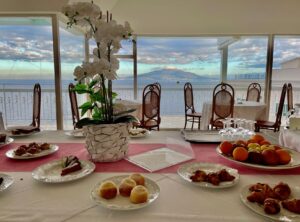
At night, Christmas decorations still twinkled from streetlamps and adorned piazzas, adding a festive glow to the city even when the streets were nearly empty.
Finding a hotel was our first challenge, as most accommodations catering to tourists were closed. Fortunately, we discovered Hotel Regina, a vision of pink stucco trimmed in white near Piazza della Vittoria, west of town near the bay. Our congenial concierge upgraded our room and sent up a chilled bottle of prosecco.
Room with a view of Mt. Vesuvius
Our small room had a balcony with two chairs–and a drop-dead view of Mount Vesuvius. After unpacking, we stepped outside to toast our good fortune. The wind was brisk, but the sky was bright with stars.
The next morning, we joined a handful of other guests in the hotel’s lovely rooftop dining room for panoramic views and a lavish selection of local pastries, meats, cheeses, and fruit.
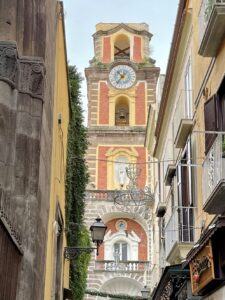
Sated with cappuccino and lemon coffee cake, we set out to explore Sorrento on foot, armed with a hotel map. The downtown area resides atop a ledge that wraps around the jagged Sorrentine Peninsula, with hotels and restaurants clinging to steep slopes above the city. Below, on the waterfront, are two harbors separated by a narrow strip of land that is full of beach clubs and sun worshipers in the summer months.
Strolling historic streets of Sorrento
We strolled along Corso Italia, a lively, mostly pedestrian street lined with tourist shops, sidewalk cafes, and an 11th century bell tower. An important trading city in the Middle Ages, Sorrento has a handful of historic churches, including the city cathedral near the bell tower that has impressive inlaid-wood doors. The main square on Corso Italia is Piazza de Tasso, which is also the heart of the city and connects the older and newer sections. (A giant Christmas tree dominated the square when we were there.)
From there it is a short walk to the train station, which has service to Naples that includes a stop at a Pompeii, the city destroyed by the eruption of Mount Vesuvius in 79 A.D. Past the station is I Giardini di Cataldo, an urban citrus garden with dozens of lemon and orange trees. Sorrento is known for its citrus crops, especially large, luscious lemons used to make sweets and limoncello. The garden typically offers samples and sells citrus products. Though it was closed the day we stopped, we could still smell the fragrant fruit from outside the gates.
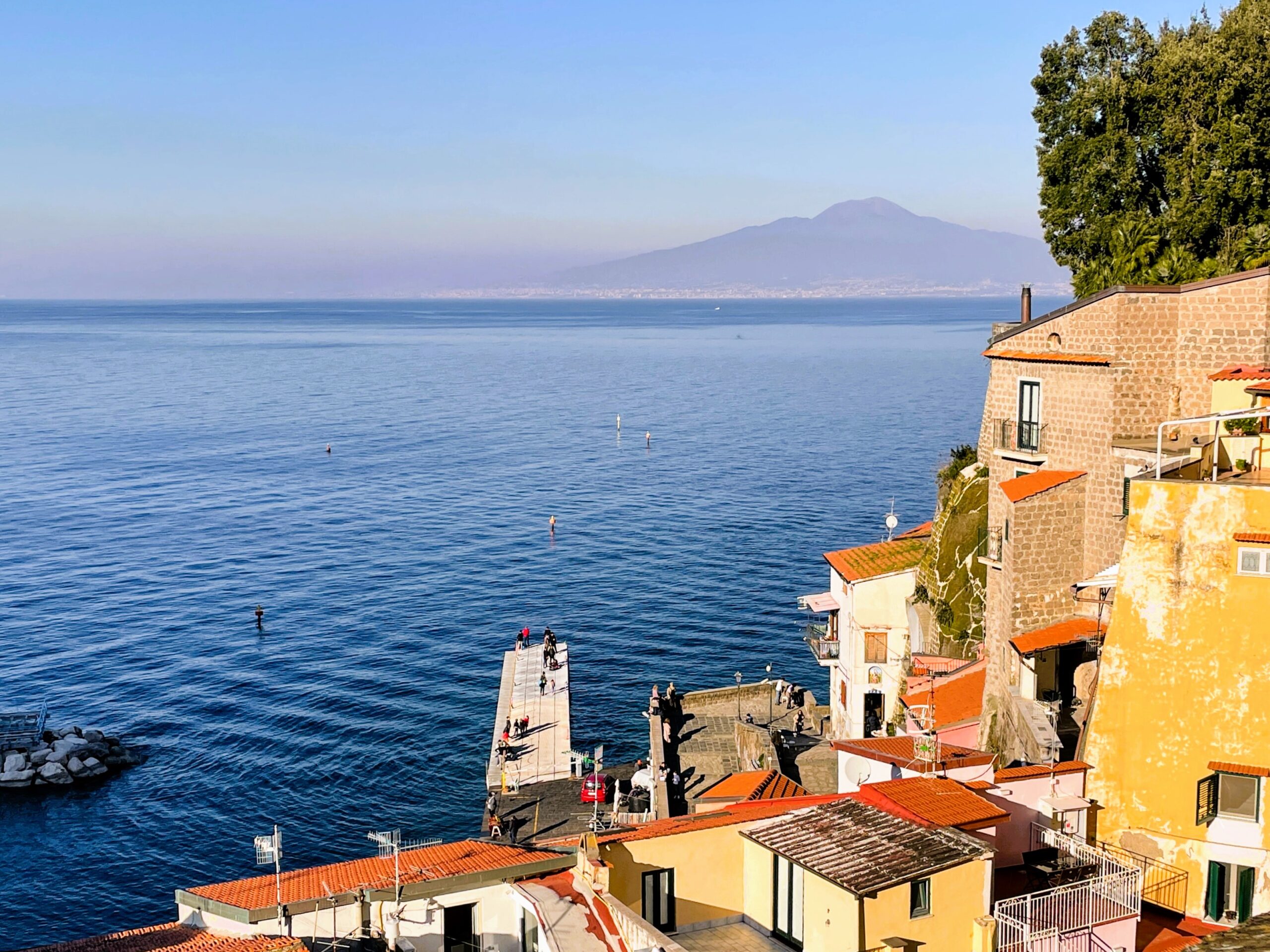
We could see the waterfront below from viewpoints around the city, but we initially could not figure out how to get there. Then we discovered La Villa Comunale, a pretty park with a terrace overlooking Marina Picolo, which–despite its name–is the city’s main transportation hub. Steps begin at the park and zigzag down the steep cliffside to the beach area. Thankfully, there’s also an elevator, which we took for € 1 each way. The beach clubs were deserted, but people mingled around the marina, waiting for public ferries to depart for Naples, Capri, and the Amalfi Coast.
Down to the marinas
Another day we hiked a narrow road through one of the city’s original gates and then down a steep stairway to Marina Grande. Older and more traditional looking, this marina is frequented by locals and small fishing and pleasure boats. Several men were repairing fishing nets on the docks, while couples sipped drinks outside a small café with views of the glistening bay at sunset.
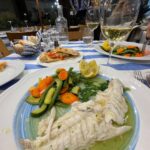
With help from our concierge, we dined at several restaurants serving excellent local seafood. Our favorite meal at Ristorante L’Abate included creamy lobster risotto followed by pan-seared sea bass, expertly fileted at our table. Our meal was paired with a tasty Falanghina wine, a regional wine that benefits from the abundant sunshine and rich volcanic soil of the Sorrentine Peninsula.
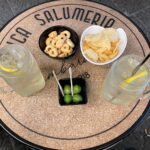
Already fans of the Venetian spritz cocktail, we fell in love with the southern Italian version–limoncello spritzes–at Antica Salumeria Gambardella, a deli-wine bar with whimsical cork-shaped stools. Gambardella, which also serves delicious mortadella sandwiches and generous charcuterie boards, turned out to be a perfect place to watch the passeggiatas–the parade of people strolling–along Corso Italia on our last night.
As we headed for Rome the next day, my friend and I agreed that off-season might be the best season to visit Sorrento.
 As a journalist, I’ve written about crime for newspapers, business deals for magazines, cruise ship ports for online travel publications and industry trends for websites. My focus now is exclusively on travel.
As a journalist, I’ve written about crime for newspapers, business deals for magazines, cruise ship ports for online travel publications and industry trends for websites. My focus now is exclusively on travel. 


No reservations for Italy? Amazing – more like 50 years ago.